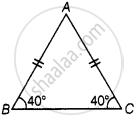Advertisements
Advertisements
प्रश्न
If in an isosceles triangle, each of the base angles is 40°, then the triangle is ______.
पर्याय
Right-angled triangle
Acute angled triangle
Obtuse angled triangle
Isosceles right-angled triangle
उत्तर
If in an isosceles triangle, each of the base angles is 40°, then the triangle is obtuse angled triangle.
Explanation:
As we know, the sum of the interior angles of a triangle is 180°.

In ΔABC,
∠A + ∠B + ∠C = 180° ......[Angle sum property of a triangle]
⇒ ∠A + 40° + 40° = 180°
⇒ ∠A = 180° – 80°
⇒ ∠A = 100° ......[Obtuse angle]
Therefore, it is an obtuse-angled triangle. Since, it has one angle which is greater than 90°.
APPEARS IN
संबंधित प्रश्न
The base of an isosceles triangle is 24 cm and its area is 192 sq. cm. Find its perimeter.
Find the perimeter of an equilateral triangle whose area is `16sqrt(3)"cm"`.
Find the area of an equilateral triangle having perimeter of 18cm.
The area of an equilateral triangle is numerically equal to its perimeter. Find the length of its sides, correct two decimal places.
In a right-angled triangle PQR right-angled at Q, QR = x cm, PQ = (x + 7) cm and area = 30 cm2. Find the sides of the triangle.
Find the area of an isosceles triangle whose perimeter is 72cm and the base is 20cm.
Find the base of an isosceles triangle whose area is 192cm2 and the length of one of the equal sides is 20cm.
A wire when bent in the form of a square encloses an area of 16 cm2. Find the area enclosed by it when the same wire is bent in the form of a rectangle whose sides are in the ratio of 1 : 3
The cross-section of a canal is a trapezium in shape. If the canal is 10m wide at the top, 6m wide at the bottom and the area of cross-section is 72 sq.m, determine its depth.
In an isosceles triangle, angles opposite to equal sides are ______.
